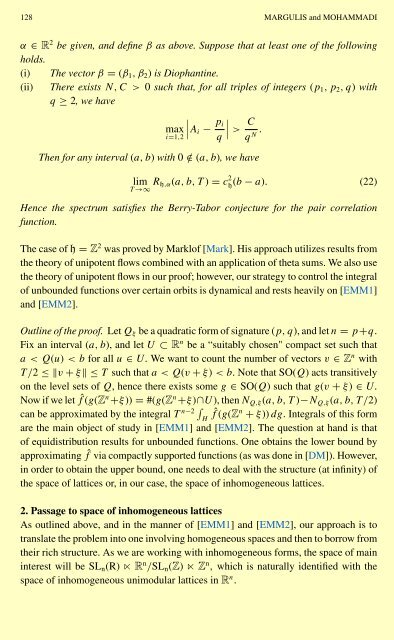NEAR OPTIMAL BOUNDS IN FREIMAN'S THEOREM
NEAR OPTIMAL BOUNDS IN FREIMAN'S THEOREM
NEAR OPTIMAL BOUNDS IN FREIMAN'S THEOREM
You also want an ePaper? Increase the reach of your titles
YUMPU automatically turns print PDFs into web optimized ePapers that Google loves.
128 MARGULIS and MOHAMMADI<br />
α ∈ R 2 be given, and define β as above. Suppose that at least one of the following<br />
holds.<br />
(i) The vector β = (β1,β2) is Diophantine.<br />
(ii) There exists N,C > 0 such that, for all triples of integers (p1,p2,q) with<br />
q ≥ 2, we have<br />
<br />
<br />
max Ai −<br />
i=1,2<br />
pi<br />
<br />
<br />
><br />
q<br />
C<br />
q<br />
Then for any interval (a,b) with 0 /∈ (a,b), we have<br />
lim<br />
T →∞ Rh,α(a,b,T ) = c 2<br />
h (b − a). (22)<br />
Hence the spectrum satisfies the Berry-Tabor conjecture for the pair correlation<br />
function.<br />
The case of h = Z 2 was proved by Marklof [Mark]. His approach utilizes results from<br />
the theory of unipotent flows combined with an application of theta sums. We also use<br />
the theory of unipotent flows in our proof; however, our strategy to control the integral<br />
of unbounded functions over certain orbits is dynamical and rests heavily on [EMM1]<br />
and [EMM2].<br />
Outline of the proof. Let Qξ be a quadratic form of signature (p, q),andletn = p+q.<br />
Fix an interval (a,b), andletU⊂Rnbe a “suitably chosen" compact set such that<br />
a

















